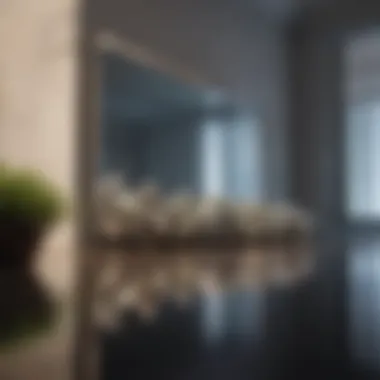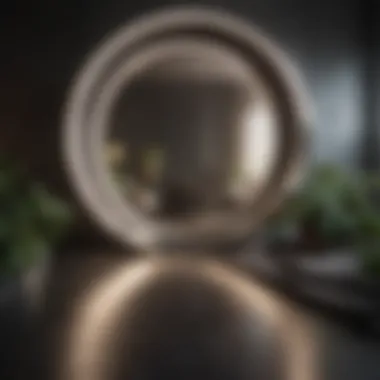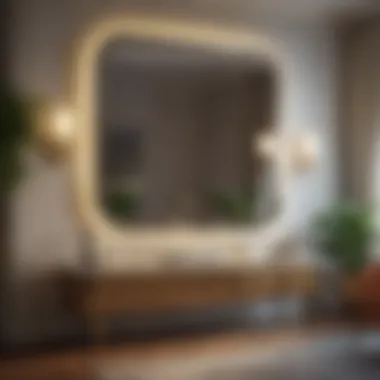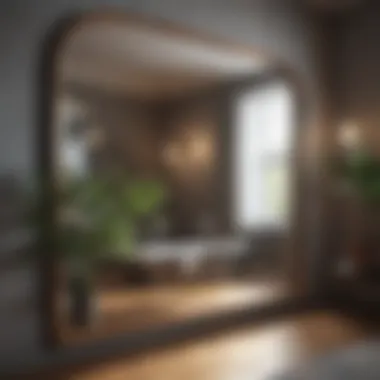Unveiling the Intriguing Role of Mirrors in Room Design for Illuminating Spaces


Interior Design Tips
Mirrors play a pivotal role in room design, offering a myriad of benefits beyond mere reflection. They can significantly enhance spatial perception, manipulate natural light distribution, and elevate the overall aesthetic appeal of a space. By strategically placing mirrors, one can create the illusion of larger rooms and amplify the feeling of openness. The reflective surfaces can also bounce light throughout the room, brightening dim corners and adding a touch of warmth. When considering interior design elements, incorporating mirrors innovatively can truly transform living spaces into visually captivating environments.
Trendy Design Ideas
In the realm of contemporary interior design, mirrors have emerged as versatile and fashionable accessories. Embracing the trend of using oversized mirrors or stylish decorative mirrors can make a bold statement in any room. Mixing different shapes and frames can add visual interest and uniqueness to the decor, while antique or vintage mirrors can infuse a sense of elegance and character. Moreover, incorporating mirror walls or mosaic mirror patterns can create a sophisticated and dynamic focal point, reflecting modern design sensibilities that resonate with today's aesthetic preferences.
Color Schemes and Combinations
When integrating mirrors into room design, it is essential to consider their interaction with color schemes and combinations. Mirrors can not only amplify the impact of existing colors but also introduce new elements of reflection that complement or contrast with the palette. Opting for mirrors with colored or tinted glass can introduce subtle hues to the room, enhancing the overall color scheme. Additionally, using mirrors strategically to reflect specific colors or textures can create visual depth and richness, amplifying the allure of the chosen color palette. By harmonizing mirrors with the existing colors in a room, one can achieve a cohesive and visually appealing design scheme.
Furniture Arrangement Techniques
Maximizing the impact of mirrors in room design necessitates thoughtful consideration of furniture arrangement. Placing mirrors opposite windows or light sources can optimize natural light distribution, illuminating the space and reducing the need for artificial lighting during daylight hours. Mirrors positioned strategically behind furniture can create the illusion of extended space, making rooms appear more expansive and airy. Moreover, integrating mirrored furniture pieces or accessories can complement the reflective quality of mirrors, harmonizing the design and promoting a cohesive aesthetic. Careful furniture placement can enhance the visual impact of mirrors, creating a harmonious and balanced environment that exudes sophistication and style.
Introduction to Mirrors in Interior Design
Mirrors hold a profound significance in the realm of interior design, serving as dynamic elements that transform living spaces. Their role extends beyond mere reflection, influencing space perception, light dynamics, and overall aesthetics. By strategically incorporating mirrors, homeowners can elevate ambiance and unlock creative possibilities in room design. This section will delve into the multifaceted aspects of mirrors in interior design, shedding light on their broad impact on room functionality and visual appeal.
History and Evolution of Mirrors
Ancient Origins of Mirrors
Mirrors have a rich historical background, with their origins tracing back to ancient civilizations such as Mesopotamia and Egypt. The craftsmanship and artistry involved in creating mirrors during these early times laid the foundation for their symbolic and practical significance. The ancient mirrors, typically crafted from polished metals like bronze or copper, reflected the skill and ingenuity of early artisans. While these mirrors provided functional value, they also held symbolic importance in rituals and cultural practices.
Technological Advancements in Mirror Production


The evolution of mirror production techniques marked a significant shift from metal to glass-based mirrors. The invention of silver-backed glass mirrors revolutionized the industry, offering superior reflective properties and clarity. This technological advancement not only improved mirror quality but also expanded design possibilities. Glass mirrors allowed for intricate detailing and larger sizes, catering to a growing demand for diverse mirror styles. Despite the advantages of glass mirrors, challenges such as fragility and maintenance emerged, highlighting the ongoing quest for innovation in mirror production.
Psychological Impact of Mirrors
Influence on Mood and Perception
The presence of mirrors in a room can profoundly impact an individual's mood and perception. Reflective surfaces have the potential to manipulate light and create illusions of space and depth, influencing the overall atmosphere of a room. Mirrors strategically placed to enhance natural light can uplift spirits and create a sense of brightness and positivity. However, improper placement or overuse of mirrors may lead to visual clutter and distortion, affecting occupants' psychological comfort.
Mirror Neurons and Social Behavior
Mirror neurons play a crucial role in social behavior and interpersonal interactions. When individuals perceive themselves in mirrors, mirror neurons are activated, fostering empathy and self-awareness. The presence of mirrors in communal spaces can promote social bonding and emotional connectivity, shaping the dynamics of social gatherings. Understanding the cognitive impact of mirrors can guide homeowners in leveraging these reflective surfaces to create engaging and harmonious environments.
Functional Versatility of Mirrors
Enhancing Natural Light
Mirrors serve as effective tools for enhancing natural light within interior spaces. By strategically placing mirrors to reflect sunlight or artificial lighting, homeowners can amplify brightness and warmth. This optical technique not only reduces the need for additional light sources but also creates a sense of openness and airiness. Harnessing the natural light-enhancing properties of mirrors can significantly transform the ambiance of a room, making it visually appealing and inviting.
Creating Visual Depth
The ability of mirrors to create visual depth is a key element in interior design, especially for smaller or enclosed spaces. Strategically positioning mirrors to reflect distant views or architectural features can expand the perceived dimensions of a room. This visual illusion of depth adds a layer of complexity to room design, making it more captivating and stimulating. However, excessive reliance on mirrors for visual depth may lead to visual distortion or overwhelm, necessitating careful consideration in integrating mirrors into the overall design scheme.
Strategic Placement of Mirrors
In the realm of interior design, mirrors play a pivotal role in not just reflecting images but also in manipulating space and light dynamics. Strategic Placement of Mirrors is a critical aspect that interior designers meticulously consider to optimize the benefits mirrors offer. By strategically placing mirrors in a room, designers can enhance natural light diffusion, create illusions of space expansion, and elevate the overall aesthetics of the space. Mirrors strategically positioned across from windows can effectively bounce natural light, making the room appear brighter and more spacious. Moreover, placing mirrors on walls opposite to doorways can visually extend the space, giving an impression of a larger room. The choice of mirror size, frame design, and placement angles are all integral considerations when strategically placing mirrors in a room.
Optical Illusions and Spatial Expansion
Reflective Surfaces and Room Perception


One of the captivating attributes of mirrors lies in their ability to create optical illusions and influence spatial perception. Reflective Surfaces and Room Perception go hand in hand by allowing mirrors to mimic spaces beyond their physical boundaries. Mirrors with large reflective surfaces can make a room feel grander and more open by mirroring existing elements like furniture, artwork, or architecture. This optical trickery not only adds depth and dimension to the space but also enhances the overall ambiance. Integrating mirrors strategically to reflect appealing elements can significantly transform the room's atmosphere and make it more inviting and impressive.
Tricks for Maximizing Space with Mirrors
Tricks for Maximizing Space with Mirrors involve mastering the art of illusion through mirror placement techniques that amplify spatial dimensions. By strategically positioning mirrors at focal points or near architectural features like alcoves or columns, designers can visually expand the room. Additionally, placing mirrors behind furniture pieces or opposite to prominent design elements can give the impression of a seamless continuation of space. The strategic use of mirrors to maximize space not only adds functionality but also fosters a sense of continuity and coherence in the room's layout, creating a harmonious visual flow.
Balancing Aesthetics and Functionality
Integration with Decor Styles
Integrating mirrors with diverse decor styles is a testament to their versatile nature in balancing aesthetics and functionality. Mirrors can seamlessly blend with various decor themes, from minimalist and modern to classic and eclectic, enhancing the overall design harmoniously. The reflective properties of mirrors can complement different textures, colors, and patterns present in the room, creating a cohesive and visually stimulating ensemble. Whether used as a statement piece or as a subtle addition, mirrors can effortlessly integrate with decor styles, adding depth and sophistication to the space.
Practical Considerations in Mirror Placement
When focusing on Practical Considerations in Mirror Placement, aspects like size, shape, and functionality take precedence in ensuring the optimal placement of mirrors. Designers need to consider the purpose of the mirror, whether it is to enhance light, create visual interest, or serve as a decorative element. Practical considerations also encompass factors such as avoiding placing mirrors directly facing cluttered areas, choosing the appropriate height for mirrors based on the room's proportions, and ensuring that mirrors do not reflect undesirable views. By addressing these practical aspects, designers can maximize the functionality of mirrors while maintaining a cohesive and visually pleasing room design.
Mirrors as Decorative Accents
Mirrors as decorative accents play a pivotal role in interior design by adding depth, sophistication, and visual interest to a room. The strategic placement of mirrors can amplify natural light, create an illusion of more space, and enhance overall aesthetics. When considering mirrors as decorative elements, it is essential to focus on specific elements such as size, frame design, and placement to achieve the desired impact. The benefits of using mirrors as decorative accents are manifold, ranging from brightening up dark corners to making small rooms appear larger. Careful consideration of the room's decor style and color palette is crucial to seamlessly integrate mirrors for a harmonious look. Homeowners and interior design enthusiasts can harness the reflective properties of mirrors to elevate the ambiance of any space.
Artistic Expressions and Statement Pieces
Customized Mirror Designs
Customized mirror designs offer a unique touch to room decor by allowing individuals to personalize their living spaces with bespoke creations. These specially crafted mirrors cater to specific style preferences and aesthetic requirements, ensuring a one-of-a-kind addition to any room. Key characteristics of customized mirror designs include intricate detailing, ornate frames, and tailor-made shapes and sizes. The popularity of customized mirror designs lies in their ability to serve as statement pieces that reflect individuality and sophistication. Despite their higher cost compared to standard mirrors, the advantages of customized designs lie in their exclusivity and ability to truly reflect the homeowner's personal taste and style. Incorporating customized mirror designs into interior decor adds a touch of elegance and luxury, making them a worthwhile choice for those looking to make a lasting impression.
Creating Focal Points in Room Design


Creating focal points in room design through strategic mirror placement can enhance the overall aesthetic appeal and draw attention to specific areas. By using mirrors as focal points, homeowners can direct the eye towards architectural features, artwork, or other design elements. The key characteristic of creating focal points with mirrors is the ability to amplify visual interest and add a dynamic dimension to the room. This design strategy is a popular choice for those seeking to introduce flair and personality into their living spaces. While creating focal points with mirrors can be visually striking, it is essential to consider proportion and balance to prevent overwhelming the room. Finding the perfect placement for a statement mirror ensures that it complements the existing decor while adding a touch of creativity and style.
Reflections of Personal Style
Incorporating Mirrors into Personalized Spaces
Incorporating mirrors into personalized spaces allows individuals to infuse their unique aesthetic preferences and design sensibilities into their homes. The key characteristic of this approach is the ability to tailor mirror placements to reflect the homeowner's personality and lifestyle. By strategically placing mirrors in areas that highlight personal interests or memories, individuals can personalize their living spaces with meaningful reflections. The popularity of incorporating mirrors into personalized spaces lies in the emotional connection and sense of identity it imparts to the room. While this approach enhances visual appeal, it is essential to strike a balance between functionality and sentiment to create a space that is both aesthetically pleasing and personally meaningful. Homeowners looking to create a home environment that reflects their individuality can utilize mirrors as versatile tools for self-expression.
Reflecting Individual Taste and Preferences
Reflecting individual taste and preferences through mirror selection and placement allows for a personalized touch in room design. The key characteristic of reflecting individual style with mirrors is the capacity to convey specific design aesthetics and personal preferences. Choosing mirrors that align with individual tastes, whether minimalist, eclectic, or traditional, is crucial to curating a space that resonates with the homeowner. The benefits of reflecting individual taste and preferences through mirrors include showcasing unique design sensibilities, creating a cohesive theme, and adding a personal touch to the decor. While this approach offers creative freedom and expression, it is important to consider coherence and harmony in mirror selection to ensure a cohesive visual narrative throughout the room. Homeowners can transform their living spaces into reflections of their distinct style and personality through intentional mirror choices and placements.
Maintenance and Care of Mirrors
The section on Maintenance and Care of Mirrors delves into the crucial aspects that contribute to the longevity and upkeep of mirrors in a room design setting. Understanding the significance of proper maintenance is essential for preserving the visual appeal and functionality of mirrors. By addressing specific elements such as cleaning techniques, preservation methods, and protective measures, homeowners and interior design enthusiasts can ensure that their mirrors remain in optimal condition over time. This section emphasizes the importance of regular maintenance to avoid issues such as degradation, smudges, or damage that could detract from the overall aesthetic impact of mirrors within a space.
Cleaning Techniques and Preservation
Safe Cleaning Methods for Different Mirror Types
Exploring safe cleaning methods tailored for different mirror types is paramount in maintaining the pristine condition of reflective surfaces. Whether dealing with antique mirrors, decorative mirrors, or mirrored furniture, utilizing the appropriate cleaning techniques is essential to prevent potential damage or discoloration. By focusing on gentle cleaning solutions, non-abrasive tools, and proper drying methods, individuals can effectively remove dust, fingerprints, or streaks without compromising the integrity of the mirror surface. Safe cleaning methods contribute significantly to the overall upkeep of mirrors, ensuring a clear and blemish-free reflection that enhances the visual appeal of room design.
Avoiding Common Mistakes in Mirror Maintenance
Identifying and avoiding common mistakes in mirror maintenance is key to preserving the longevity and quality of reflective surfaces. Neglecting proper cleaning schedules, using harsh chemicals, or scrubbing vigorously can lead to scratches, cloudiness, or deterioration of the mirror finish. By emphasizing gentle cleaning practices, regular inspections for damage, and proactive measures to address wear and tear, individuals can prevent common maintenance pitfalls that could diminish the aesthetic charm of mirrors within a room. Avoiding these mistakes optimizes the preservation of mirrors, allowing them to serve their decorative and functional purposes effectively.
Protecting Mirror Surfaces
Preventive Measures for Longevity
Implementing preventive measures aimed at enhancing the longevity of mirror surfaces is essential in maintaining their visual appeal and functionality. From strategic placement in low-traffic areas to using protective films or coatings, homeowners can shield mirrors from potential scratches, stains, or environmental factors that may impact their condition. Preventive measures promote the durable performance of mirrors over time, reducing the need for extensive repairs or replacements due to wear and tear. By considering factors such as exposure to sunlight, humidity levels, and everyday use, individuals can proactively protect mirror surfaces and ensure their lasting beauty in room design.
Managing Damage and Wear
Effectively managing damage and wear on mirror surfaces involves identifying potential issues early on and addressing them promptly. Whether dealing with surface scratches, chipped edges, or deterioration of reflective coatings, taking timely action can prevent further damage and extend the lifespan of mirrors. By engaging in regular inspections, implementing quick repairs or seeking professional restoration services when needed, individuals can mitigate the impact of wear on mirror surfaces within a room. Managing damage and wear enhances the overall maintenance efforts, ensuring that mirrors retain their aesthetic allure and functional quality with proper care and attention.







